BBC Earth newsletter
BBC Earth delivered direct to your inbox
Sign up to receive news, updates and exclusives from BBC Earth and related content from BBC Studios by email.
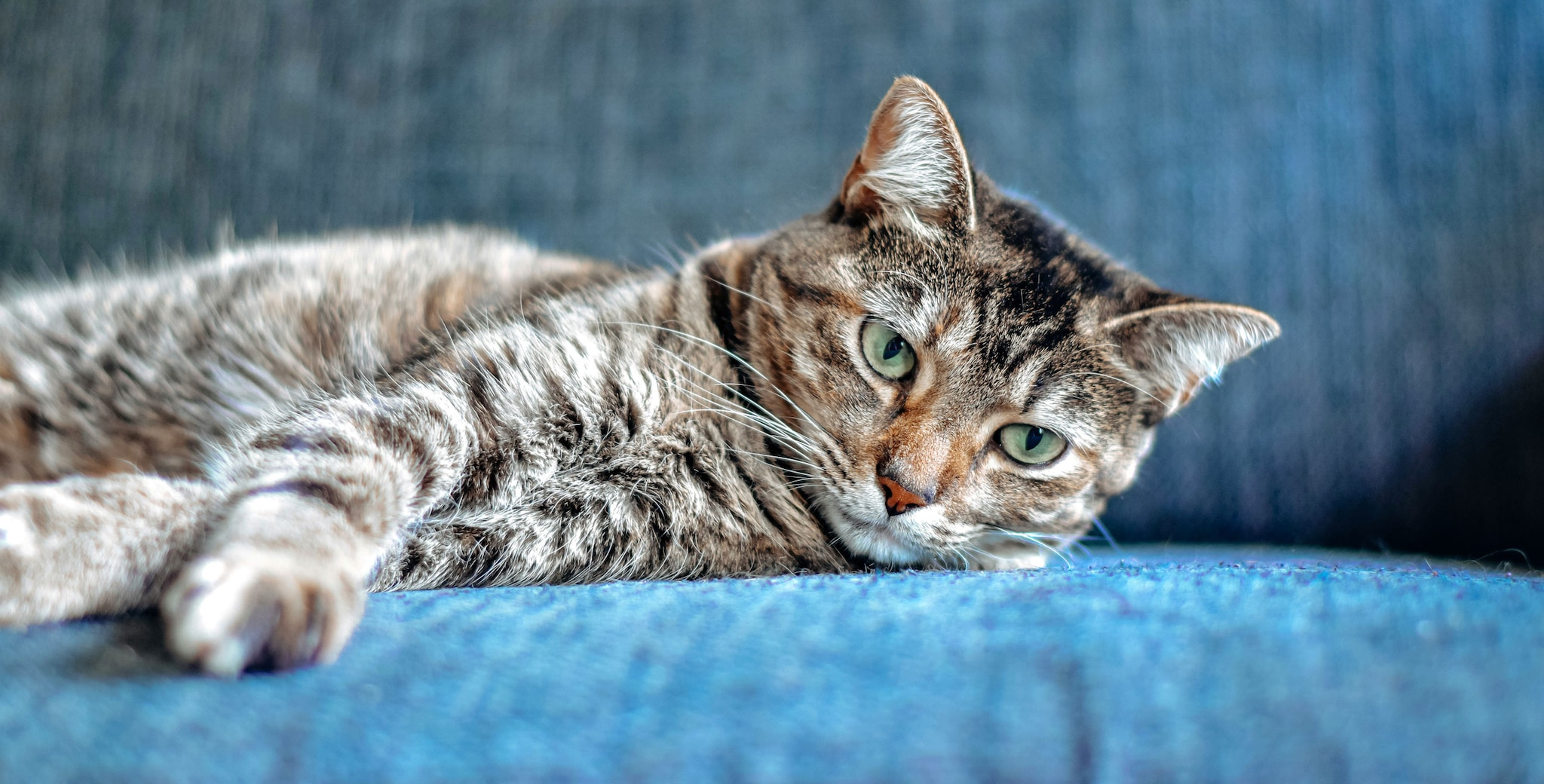
Soft, furry, and oh so cuddly - cats have lived alongside humans for more than 10,000 years. However, they have yet to lose their wild instincts.
Cats have been part of our family since our ancestors stopped being hunter-gatherers and set up the first villages. The Ancient Egyptians loved cats so much that they painted feline images on hieroglyphs and tombs.2 They revered cats and associated them with deities, and some were even mummified alongside humans in tombs. In fact, the oldest pet cemetery, established by the Ancient Egyptians, dates to around the 1st or 2nd century CE and contains 536 cats.3 Fast forward to today, and thanks to hilarious cat memes, the popularity of this pet shows no sign of waning.

DNA evidence suggests that people first began domesticating cats around 10,000 years ago in a region of the Middle East known as the Fertile Crescent, although other estimates suggest the process may have begun as early as 12,000 years ago. This area, which encompasses parts of Iraq, Israel, Jordan, Lebanon and Syria, is where humans first started settling down and creating farms and villages.4 Modern-day cats are descended from a subspecies of the African wildcat, Felis silvestris lybica. It’s likely that thousands of years ago these felines were attracted to human settlements, enticed by the scraps of food they found there. People realised these mouse-catchers were useful companions, and a beautiful relationship was born.
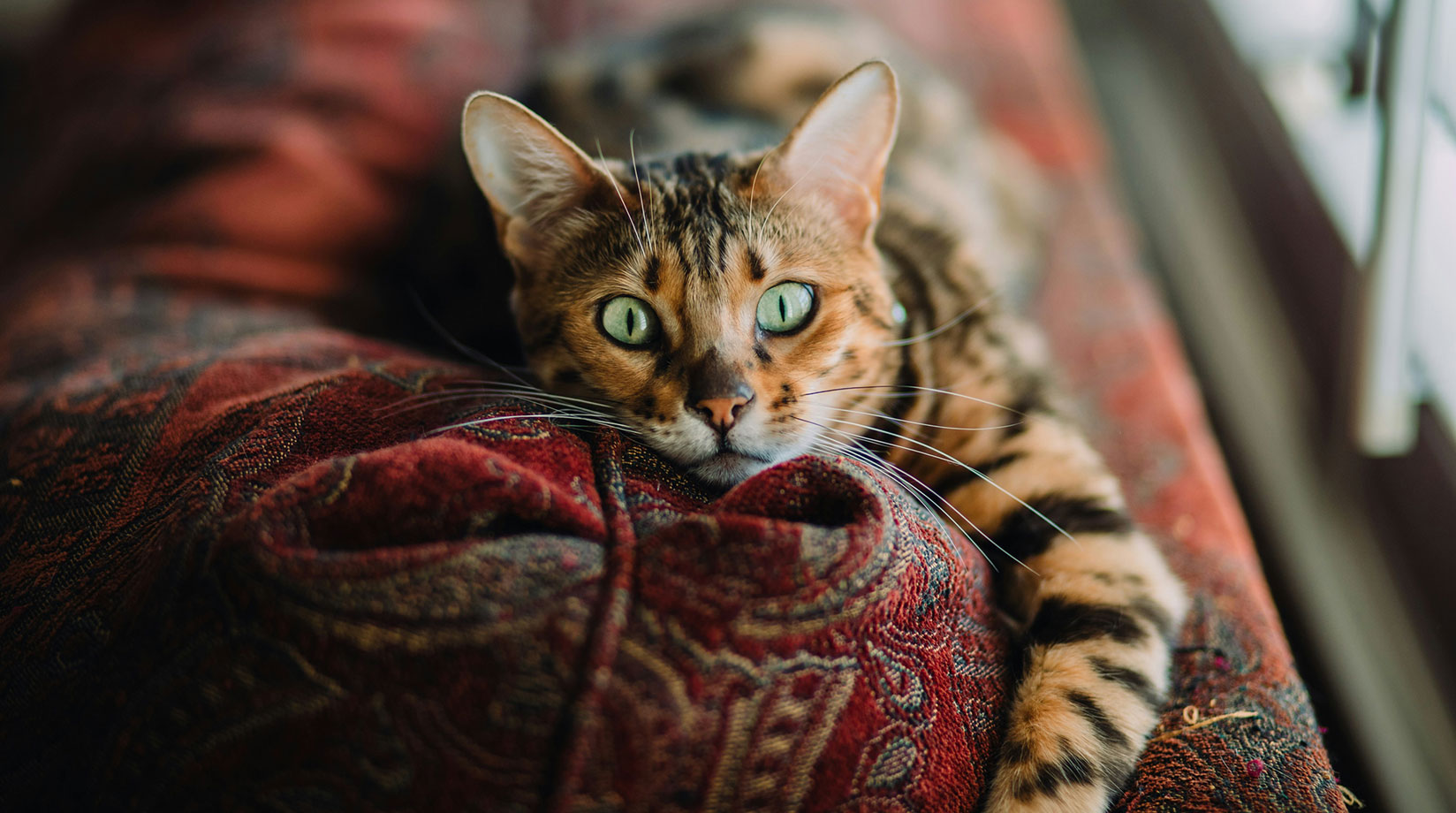
A recent study in the UK shows that pet cats live for an average of 11.74 years.5 The research found that female cats have a slightly longer average lifespan at 12.51 years compared to 11.18 for males. The study also found that the breed of cat can also affect its lifespan. Burmese and Birman cats have the longest average lifespans at 14.42 years and 14.39 years, respectively. On the other hand, sphynx cats have the shortest average life expectancy at 6.68 years. Bengal cats also have relatively short lifespans at 8.5 years on average. According to the same study, non-pedigree "moggies" live on average 1.5 years longer than purebred cats. If you want your cat to live a long life, then neutering them and keeping their body weight within a healthy range can increase their longevity.
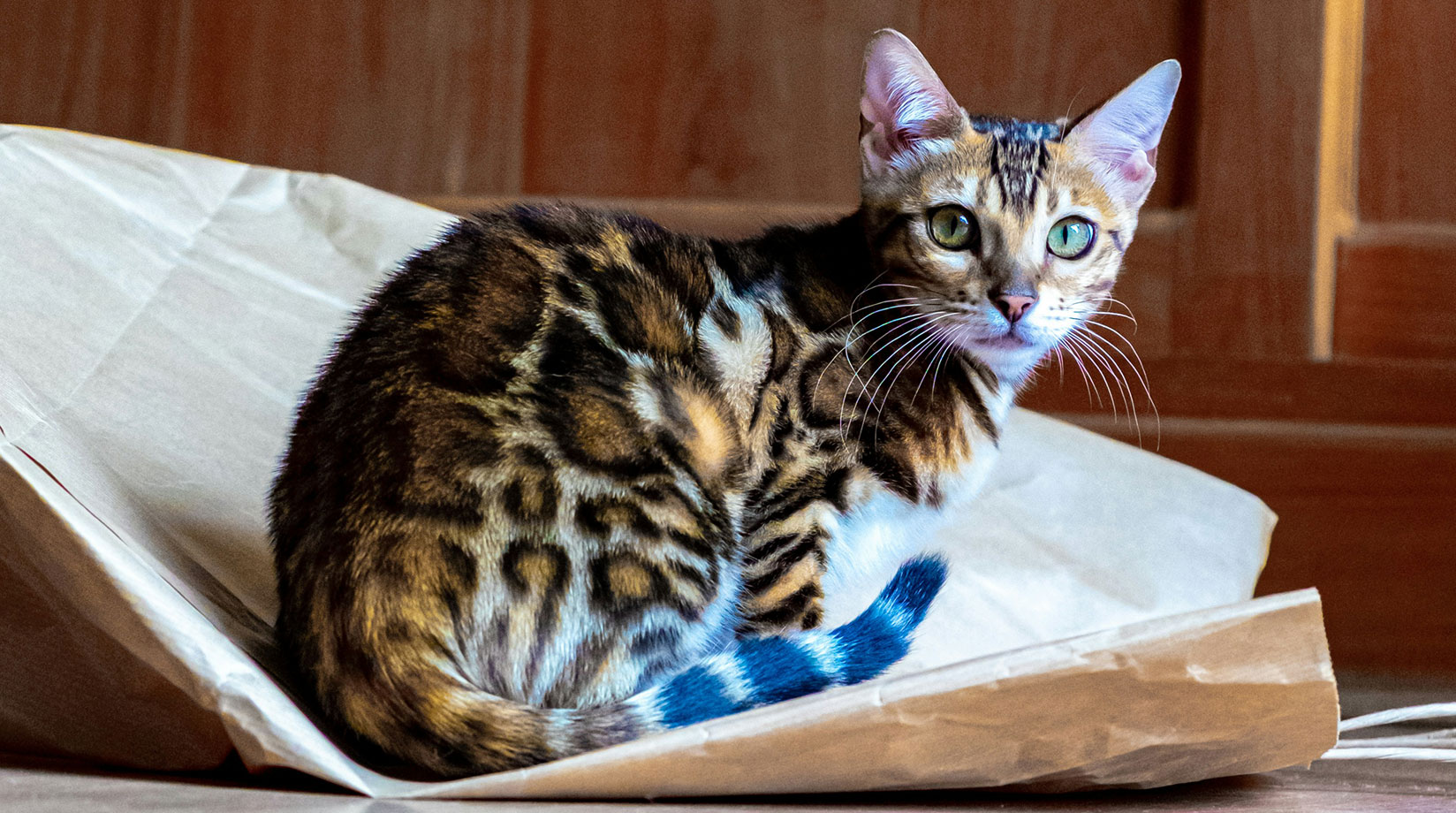
For a cat lover, few things are more comforting than when a feline friend curls up in your lap and offers a contented purr. It’s not just domestic cats that purr – larger felines such as pumas and cheetahs do too. While it might seem that cats purr purely as a sign of love, happiness or pleasure, the reality is more complicated than that.
A landmark study in 1991 revealed how cats produce the purring sound. The sound originates from the feline’s voice box, or larynx. When a cat breathes, its glottis (the area around the vocal cords), rapidly dilates and constricts, causing air to vibrate and produce the familiar purr.6
However, the question of why cats purr remains debated. Kittens start purring a few days after birth to attract their mother’s attention, and many continue to purr into adulthood to encourage their owners to feed them.
One theory is that cats purr to heal or soothe themselves. It’s been suggested that the frequency of a cat’s purr, which ranges between 20Hz and 150Hz, is physically rejuvenating, and could provide pain relief or even promote bone growth.7 Anecdotally, cats have been known to purr when they are dying or being put to sleep. Cats also sometimes purr when they are severely injured or frightened. The healing power of a cat’s purr may even translate to humans, as some studies suggest that owning a cat could cut the risk of stroke or heart disease by as much one-third.8
Cats may also purr to manipulate their owners. One study found that a "mew" sound hidden within a cat's purr can elicit nurturing feelings in owners, much like a newborn baby's cry.9 According to the authors, when purring to demand food, cats make "more urgent and less pleasant" sounds.10
While it might seem that cats purr purely as a sign of love, happiness or pleasure, the reality is more complicated than that.
Unlike the purr, which is a mainstay of feline-to-feline communication, adult cats rarely miaow at one another. For example, kittens miaow at their mothers to signal that they are hungry, but this behaviour stops once they reach adulthood. Miaowing is also uncommon in feral cat colonies11 with feral cats seldom miaowing at humans.12 It appears, therefore, that domestic cats may have finessed their miaow specifically to attract human attention and communicate with us.13
The miaow of an individual cat is quite distinct, and cats can even vary the pitch, duration and melody of their miaow depending on the meaning they want to convey and their emotional state.14
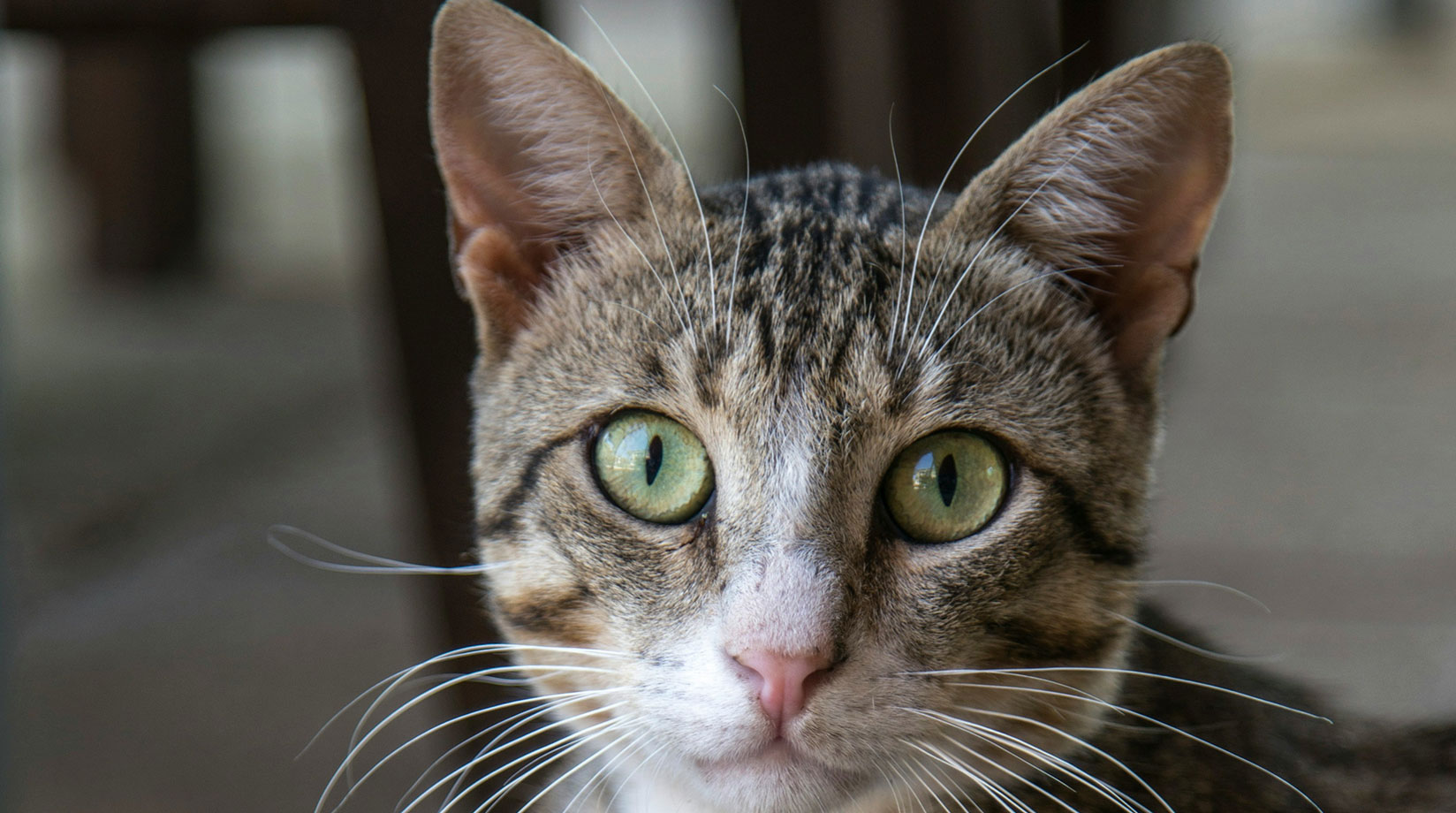
You may have noticed that when your cat is feeling extra affectionate, they will rhythmically “knead” your lap by extending and retracting their paws one at a time. Kittens knead their mother's bellies when suckling, and it’s believed this behaviour evolved to stimulate milk flow.15
It’s also possible that kneading serves as a way for kittens to bond with their mothers. Cats have scent glands on the underside of their soft paw pads, and when a cat kneads, these glands release chemical messengers called pheromones.16 While weaning her kittens, the mother cat also releases a chemical called “cat appeasing pheromone” from her sebaceous glands, which are located close to her mammary glands.17 This pheromone is thought to help with bond formation – comforting and reassuring the kittens.
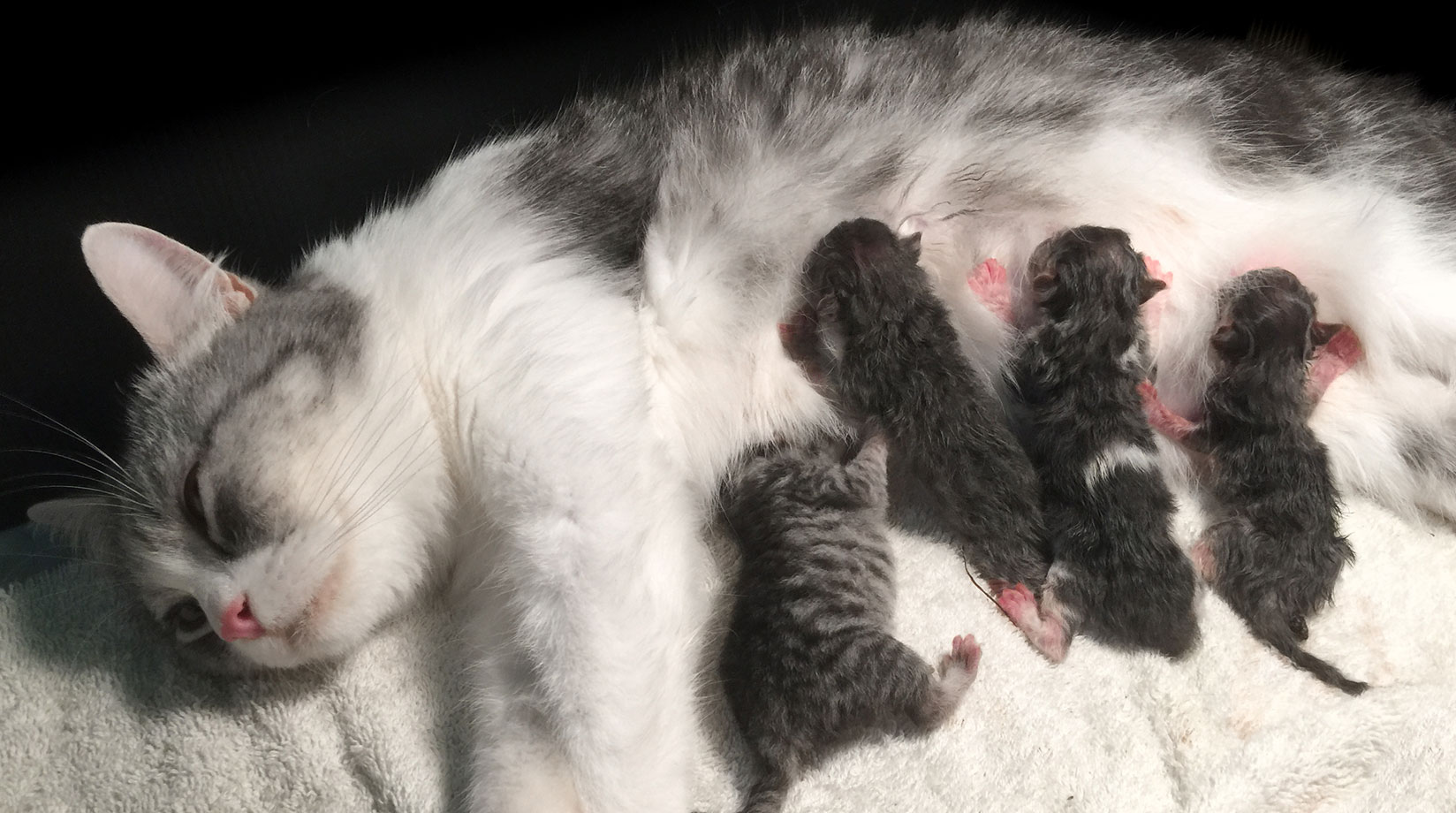
Female cats reach sexual maturity by the time they are around four months old. After that, they can go into heat as often as every 2-3 weeks. Gestation lasts about 64 days, with female cats giving birth to an average of four kittens per litter. Since cats can get pregnant at almost any time, it’s not unheard of for a litter of kittens to have multiple fathers – especially in cities where there are many potential male suitors. For example, in one study in France, researchers compared a population of pet cats who lived in a rural area, with a colony of feral cats living in an urban district.18 They found that in rural areas where the cat population was sparse – and cats lived in a home environment – a few males monopolised all of the females. These males would aggressively fight off competitors, and as a result only 0-22% of litters were fathered by more than one male. However, in the urban colony, cats lived more closely together and aggression between males and females was rare. In this population, between 70 to 83% of litters were sired by more than one father.
Cats are much better at seeing in low-light conditions than humans because they have more rod photoreceptors in their retina. These receptors are highly sensitive to dim light and are particularly attuned to movement. As a result, according to the charity Cats Protection, cats can see "six to eight times better" than humans when it is dark.19
However, there’s an important trade-off. As their retinas contain so many rods, cats have fewer cone receptors, the cells responsible for seeing during daytime. As a result, their daytime visual acuity is only about one-seventh of a human's. Additionally, cats seem unable to focus on objects closer than around 30cm.
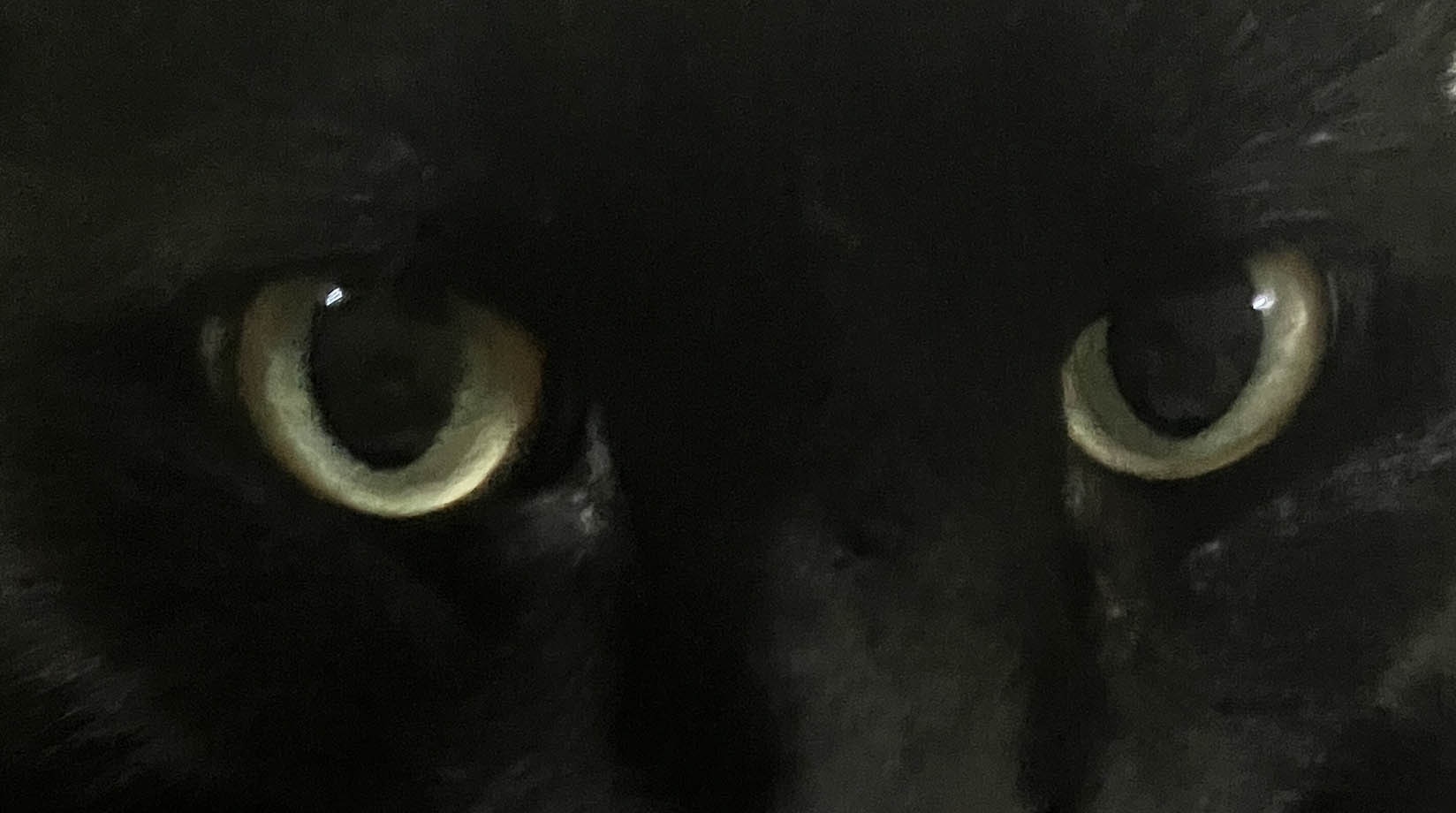
Cats don’t see colours the same way that humans do. The human eye contains three types of cone receptor – red, blue and green. Each of these receptors is activated by a corresponding frequency of light. The brain then integrates this information to help us perceive the full spectrum of visible light. Cats also have three types of cones, but the cones respond to different frequencies of light (blue, cyan, and green). This means that cats are able to perceive blue, yellow and green tones very well, but are less able to discern orange and red hues.20
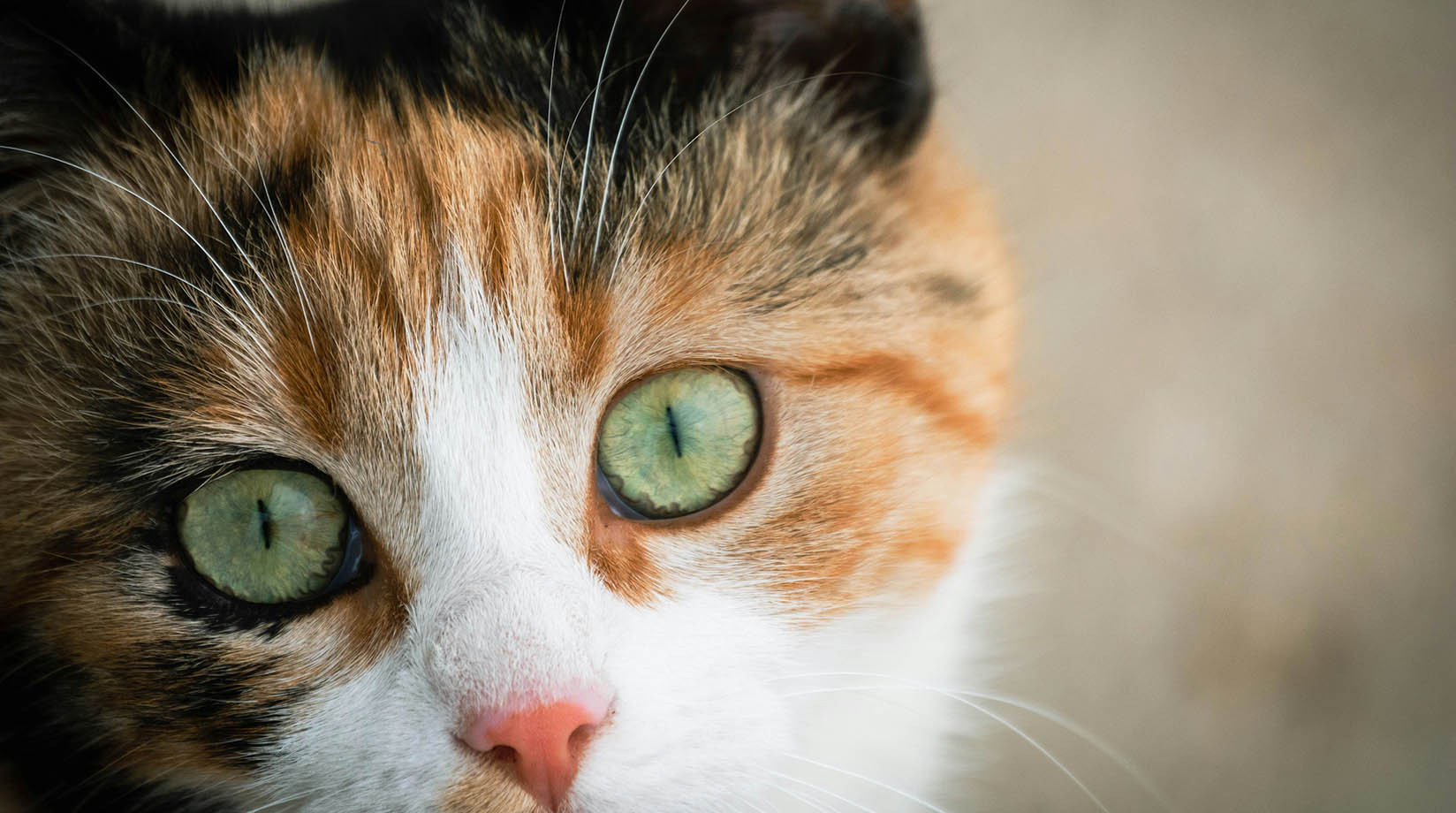
Like their wild carnivorous cousins – the lion, cheetah and leopard – house cats are obligate carnivores, meaning they require certain nutrients that are only found in meat. This sets them apart from animals like dogs, which enjoy meat, but can survive without it.
One essential nutrient for cats is the amino acid taurine, which although present in algae, is almost entirely absent in plants. While humans and dogs have enzymes that can make the amino acid taurine, cats don’t, so they must get it from fresh meat.
Cats also require arachidonic acid, which is mainly found in saturated animal fats. Their bodies are also not very good at converting carotenoids from plants into vitamin A, so they need to get this micronutrient from animal sources.
However, it is possible that these nutrients could be supplied through supplements, meaning cats could theoretically be fed a plant-based or vegan diet. The first large scale study comparing the health of vegan cats with meat-fed felines was published in 2021.21 The study found that vegan cats had lower incidences of gastrointestinal disorders, and a higher proportion of vegan cats were reported to be in very good health by their owners.
In addition to tinned cat food, our outdoor roaming feline friends like to hunt their own food. Recently, researchers compiled a database of all the animals that cats have been recorded eating and where.22 The study identified more than 2000 species, including 981 birds, 463 reptiles, 431 mammals, 119 insects, and 57 amphibians. Domestic cats have even been known to hunt endangered animals, such as juvenile green sea turtles.
Don’t be tempted to give your cat chocolate – it's highly toxic to felines. Chocolate contains two compounds, theobromine and caffeine, both of which are harmful to cats. However, research shows that cats aren’t particularly interested in sweet treats anyway. This is because cats have a defect in one of the two genes responsible for forming the sweet taste receptor.23 A large deletion of DNA from the gene means that it is unable to form a functioning protein. This defect has left cats unable to taste sweet-tasting compounds like sugar. Interestingly, this genetic mutation isn't limited to domestic cats –cheetahs, tigers, and even hyenas share this trait.
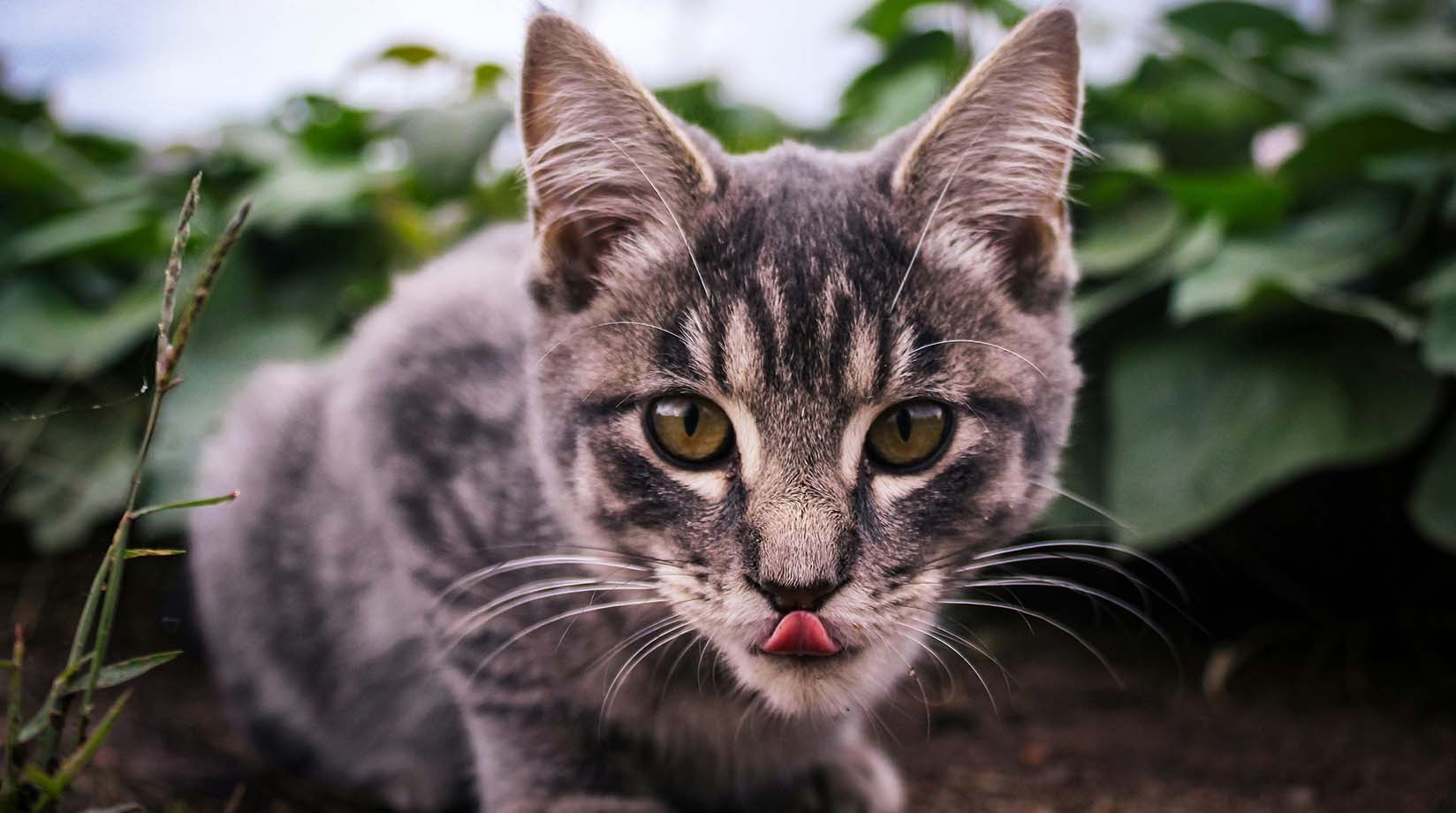
Cats often like to be out at night, and so sometimes may encounter foxes. However, the risk of a fox attacking a cat is very low.24 In most cases, cats and foxes will simply ignore or avoid each other. In February 2013, vet Dr Pete Wedderburn analysed statistics from the database VetCompass, a project run by the Royal Veterinary College in London. The database collects information on vet visits - and the reasons for them - in the UK.
The results showed that in the period January 2010 until February 2013, only five out of 10,000 cats visiting a vet in the UK did so because of being injured by a fox.25 This compares to 541 cats per 10,000 who visited following a fight with another cat in the same period. Wedderburn concludes that cats are 40 times more likely to be injured by other cats, and 14 times more likely to be injured by a road traffic accident than to be hurt by a fox.
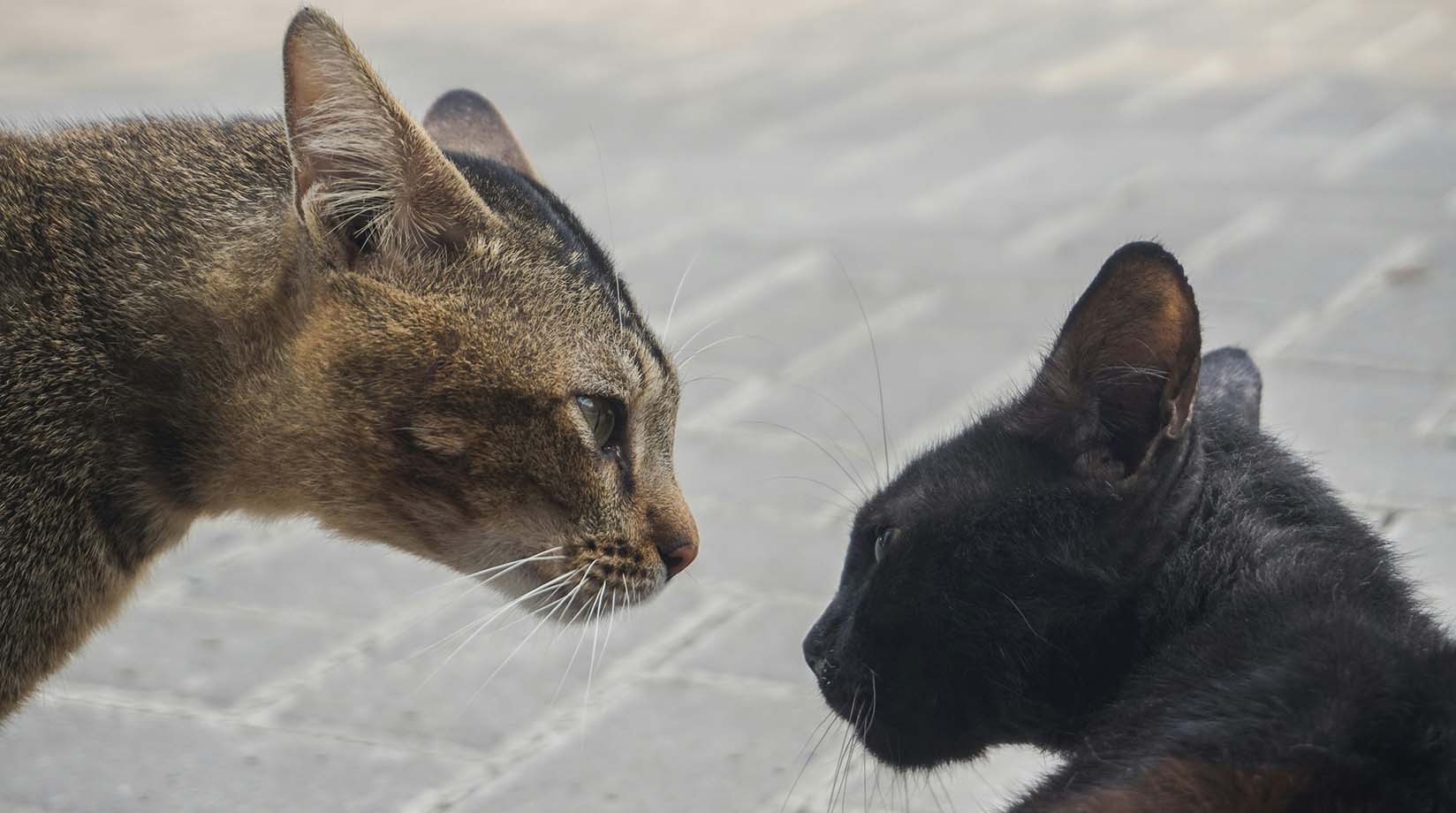
Domestic cats have a reputation for being aloof and indifferent, especially in comparison to dogs. So many owners can be forgiven for asking the question: does my cat love me? Research indicates that cats actually form very close emotional bonds with their owners.26 For instance, some cats display separation anxiety when apart from their caregiver. Cats are also more responsive to their owners’ voices than they are to a stranger’s.27 Moggies even look at their owners for reassurance when they are scared.28 In fact, one 2017 study by researchers at Oregon State University in the US found that cats preferred human interaction over food, toys or pleasant smells.29
So how can you tell whether your cat loves you? One sign to look out for is your cat rubbing its head or body against your legs. Cats have scent glands on their side, head, and around their ears. In the wild, felines use these glands to identify members of their group or family.30 So when a cat nuzzles your face, you know that it’s real love. An upright tail also shows affection, as does a slow blinking gaze.31
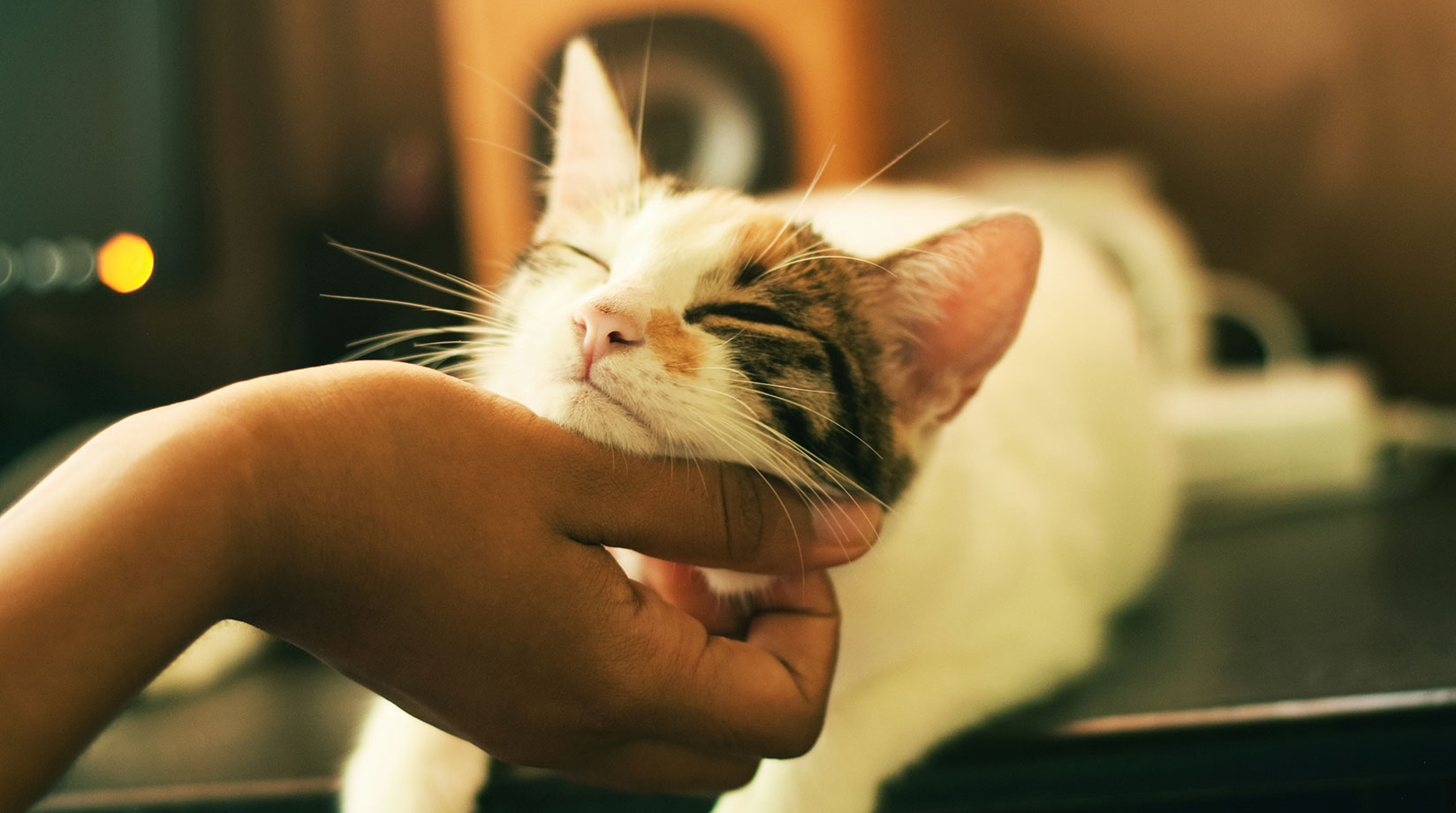
When a cat nuzzles your face, you know that it’s real love. An upright tail also shows affection, as does a slow blinking gaze.
Cats are obligate carnivores, which means they must eat meat to survive. Over time, they have evolved into skilled hunters to ensure a steady food supply. Their prey includes small rodents – like mice, rats and voles – as well as birds and even frogs. They often prefer to hunt at dusk and dawn, which is why you might have noticed your pet cat is especially active at these times.
However, pet cats arguably no longer need to hunt to meet their nutritional needs, as most are well-fed at home. So why do they still hunt? It’s all down to instinct. Even a well-fed cat will be driven to stalk, pounce and chase small creatures. It is hardwired into their nature and, in fact, estimates suggest that cats only consume around 30% of the prey they catch.32
Whiskers are specialised sensory organs that help cats gather information about their surroundings. As they move around, cats receive a constant stream of information from their whiskers about the objects close to them. These whiskers – also referred to as vibrissae – are found on their cheeks, near their eyes, and even on their ankles. Each of these wiry hairs sits deeply in the skin, where it connects to muscles as well as never endings. From this sensory information, the cat can tell how far each whisker is being bent back, and how quickly. A cat's cheek whiskers are approximately the same width as their body, allowing them to judge distances and to navigate the narrowest spaces.
Catnip is an oil found in the stems and leaves of the catnip plant Nepeta cataria.
When cats smell catnip they exhibit several unusual behaviours – rubbing their heads and bodies on the plant, jumping, rolling around, miaowing and salivating. Cats can detect catnip concentrations as low as one part in a billion.33 However, not all cats are affected by it. Studies estimate that about 2 in 3 cats react to it, and it appears that the response is hereditary.34 Even some big cats like leopards and tigers can greact in the same intoxicated way.
So why do cats love catnip? Catnip contains many volatile compounds, including one chemical called nepetalactone.35 This substance is made by plants to repel insects, but it has the opposite effect on cats. We don’t know why, but it’s thought that nepetalactone mimics a pheromone that cats naturally produce, one that is linked to reproduction.36
Featured image © thewonderalice | Unsplash
Fun fact image © Ibrahim Guetar | Unsplash
Quick Facts:
1 “How Long Do Pet Cats Live?” Cats Protection, www.cats.org.uk/cats-blog/how-long-do-pet-cats-live.
2. Helgren, J. Anne. “Cat.” Encyclopædia Britannica, 14 Jan. 2019, www.britannica.com/animal/cat.
3. “Cat Weight.” Blue Cross, www.bluecross.org.uk/advice/cat/food-and-weight/cat-weight.
4. “Cat Population by Country 2023.” Worldpopulationreview.com, worldpopulationreview.com/country-rankings/cat-population-by-country.
Fact file:
1. Quaranta, Angelo, et al. “Emotion Recognition in Cats.” Animals, vol. 10, no. 7, 28 June 2020, p. 1107, https://doi.org/10.3390/ani10071107.
2. Driscoll, Carlos A, et al. “The Taming of the Cat.” Scientific American, vol. 300, no. 6, June 2009, p. 68, pmc.ncbi.nlm.nih.gov/articles/PMC5790555/.
3. PhD, Todd,. “The Average Cat Lives 11.74 Years, according to New Research.” Companion Animal Psychology, Blogger, 5 June 2024, www.companionanimalpsychology.com/2024/06/the-average-cat-lives-1174-ye…. Accessed 27 Nov. 2024.
4. Driscoll, C. A., et al. “The near Eastern Origin of Cat Domestication.” Science, vol. 317, no. 5837, 27 July 2007, pp. 519–523, https://doi.org/10.1126/science.1139518.
5. Kendy Tzu-yun Teng, et al. “Life Tables of Annual Life Expectancy and Risk Factors for Mortality in Cats in the UK.” Journal of Feline Medicine and Surgery, vol. 26, no. 5, 1 May 2024, https://doi.org/10.1177/1098612x241234556.
6. Sissom, Dawn E. Frazer, et al. “How Cats Purr.” Journal of Zoology, vol. 223, no. 1, Jan. 1991, pp. 67–78, https://doi.org/10.1111/j.1469-7998.1991.tb04749.x.
7. von Muggenthaler, Elizabeth. “The Felid Purr: A Healing Mechanism?” The Journal of the Acoustical Society of America, vol. 110, no. 5, Nov. 2001, pp. 2666–2666, https://doi.org/10.1121/1.4777098.
8. Qureshi AI, Memon MZ, Vazquez G, Suri MF. 2009. Cat ownership and the Risk of Fatal Cardiovascular Diseases. Results from the Second National Health and Nutrition Examination Study Mortality Follow-up Study. J Vasc Interv Neurol. Jan;2(1):132-5.
9. McComb, Karen. “The Cry Embedded within the Purr.” Current Biology, vol. 19, no. 13, 14 July 2009, pp. R507–R508, www.sciencedirect.com/science/article/pii/S0960982209011683, https://doi.org/10.1016/j.cub.2009.05.033; Field, Alison. “Research Reveals How Cats Purrfect the Art of Exploitation.” The University of Sussex, www.sussex.ac.uk/broadcast/read/1208.
10. Yeon, S.C., Kim, Y.K., Park, S.J., Lee, S.S., Lee, S.Y., Suh, E.H., Houpt, K.A., Chang, H.H., Lee, H.C., Yang, B.G., et al. 2011. Differences between vocalization evoked by social stimuli in feral cats and house cats. Behav. Process., 87, 183–189
11. Cameron-Beaumont, C.L. 1999. Visual and Tactile Communication in the Domestic Cat (Felis silvestris catus) and Undomesticated Small Felids. Ph.D. Thesis, University of Southampton, UK
12. Atkinson, T. 2018. Practical Feline Behaviour: Understanding Cat Behaviour and Improving Welfare; CABI: Wallingford, UK.
13. Turner, D.C. 2017. A review of over three decades of research on cat-human and human-cat interactions and relationships. Behav. Process. 141, 297–304
14. Tavernier, C., Ahmed, S., Houpt, K.A., Yeon, S.C. 2020. Feline vocal communication. J. Vet. Sci. 21.
15. Bradshaw, John W.S. “Sociality in Cats: A Comparative Review.” Journal of Veterinary Behavior, vol. 11, Jan. 2016, pp. 113–124, https://doi.org/10.1016/j.jveb.2015.09.004.
16. Pageat, Patrick, and Emmanuel Gaultier. “Current Research in Canine and Feline Pheromones.” Veterinary Clinics of North America: Small Animal Practice, vol. 33, no. 2, Mar. 2003, pp. 187–211, https://doi.org/10.1016/s0195-5616(02)00128-6.
17. DePorter, Theresa L, et al. “Evaluation of the Efficacy of an Appeasing Pheromone Diffuser Product vs Placebo for Management of Feline Aggression in Multi-Cat Households: A Pilot Study.” Journal of Feline Medicine and Surgery, vol. 21, no. 4, 14 May 2018, pp. 293–305, https://doi.org/10.1177/1098612x18774437.
18. Say, Ludovic., et al. “High Variation in Multiple Paternity of Domestic Cats (Felis Catus L.) in Relation to Environmental Conditions.” Proceedings of the Royal Society of London. Series B: Biological Sciences, vol. 266, no. 1433, 22 Oct. 1999, pp. 2071–2074, www.ncbi.nlm.nih.gov/pmc/articles/PMC1690320/pdf/10902544.pdf, https://doi.org/10.1098/rspb.1999.0889. Accessed 5 Oct. 2022.
19. “Can Cats See in the Dark? And Other Cat Eyesight Facts.” Cats Protection, www.cats.org.uk/cats-blog/cat-eyesight-facts.
20. Gardner, Lori. “What Colors Can Cats See? See the World through a Cats Eyes.” Litter-Robot.com, Whisker, 4 Dec. 2023, www.litter-robot.com/blog/what-colors-can-cats-see/?srsltid=AfmBOorZaZp…. Accessed 5 Nov. 2024.
21. Dodd, Sarah A. S., et al. “A Cross-Sectional Study of Owner-Reported Health in Canadian and American Cats Fed Meat- and Plant-Based Diets.” BMC Veterinary Research, vol. 17, no. 1, 28 Jan. 2021, https://doi.org/10.1186/s12917-021-02754-8.
22. Lepczyk, Christopher A, et al. “A Global Synthesis and Assessment of Free-Ranging Domestic Cat Diet.” Nature Communications, vol. 14, no. 1, 12 Dec. 2023, https://doi.org/10.1038/s41467-023-42766-6.
23. Li, Xia, et al. “Pseudogenization of a Sweet-Receptor Gene Accounts for Cats’ Indifference toward Sugar.” PLoS Genetics, vol. 1, no. 1, 25 July 2005, p. e3, https://doi.org/10.1371/journal.pgen.0010003.
24 Cats and Foxes | Blog. 2024, www.cats.org.uk/cats-blog/are-foxes-a-danger-to-cats.
25. “Do Foxes Eat Cats? Could Your Pet Cat Be the next Victim?” Vet Help Direct, 14 Feb. 2013, vethelpdirect.com/vetblog/2013/02/14/urban-foxes-attacks-on-cat/. Accessed 5 Nov. 2024.
26. Schwartz, Stefanie. “Separation Anxiety Syndrome in Cats: 136 Cases (1991-2000).” Journal of the American Veterinary Medical Association, vol. 220, no. 7, Apr. 2002, pp. 1028–1033, https://doi.org/10.2460/javma.2002.220.1028.; Saito, Atsuko, and Kazutaka Shinozuka. “Vocal Recognition of Owners by Domestic Cats (Felis Catus).” Animal Cognition, vol. 16, no. 4, 26 Mar. 2013, pp. 685–690, https://doi.org/10.1007/s10071-013-0620-4.
27. Merola, I., et al. “Social Referencing and Cat–Human Communication.” Animal Cognition, vol. 18, no. 3, 9 Jan. 2015, pp. 639–648, https://doi.org/10.1007/s10071-014-0832-2.
28. Shreve, Kristyn R. Vitale, et al. “Social Interaction, Food, Scent or Toys? A Formal Assessment of Domestic Pet and Shelter Cat (Felis Silvestris Catus) Preferences.” Behavioural Processes, vol. 141, 2017, pp. 322–328, www.sciencedirect.com/science/article/pii/S0376635716303424, https://doi.org/10.1016/j.beproc.2017.03.016.
29. ---. “Current Research in Canine and Feline Pheromones.” Veterinary Clinics of North America: Small Animal Practice, vol. 33, no. 2, Mar. 2003, pp. 187–211, https://doi.org/10.1016/s0195-5616(02)00128-6.
30. Finka, Lauren R. “Conspecific and Human Sociality in the Domestic Cat: Consideration of Proximate Mechanisms, Human Selection and Implications for Cat Welfare.” Animals, vol. 12, no. 3, 25 Jan. 2022, p. 298, https://doi.org/10.3390/ani12030298.
31. Humphrey, Tasmin, et al. “The Role of Cat Eye Narrowing Movements in Cat–Human Communication.” Scientific Reports, vol. 10, no. 1, 5 Oct. 2020, p. 16503, www.nature.com/articles/s41598-020-73426-0, https://doi.org/10.1038/s41598-020-73426-0.
32. “Cat Hunting Behaviors.” Www.purina.com, www.purina.com/articles/cat/behavior/understanding-cats/cat-hunting-beh….
33. Lichman, Benjamin R., et al. “The Evolutionary Origins of the Cat Attractant Nepetalactone in Catnip.” Science Advances, vol. 6, no. 20, 1 May 2020, p. eaba0721, advances.sciencemag.org/content/6/20/eaba0721, https://doi.org/10.1126/sciadv.aba0721.
34. Bol, Sebastiaan, et al. “Responsiveness of Cats (Felidae) to Silver Vine (Actinidia Polygama), Tatarian Honeysuckle (Lonicera Tatarica), Valerian (Valeriana Officinalis) and Catnip (Nepeta Cataria).” BMC Veterinary Research, vol. 13, no. 13, 16 Mar. 2017, www.ncbi.nlm.nih.gov/pmc/articles/PMC5356310/#CR10, https://doi.org/10.1186/s12917-017-0987-6.
35. Adams, Christian. “How Far Away Can Cats Smell Catnip? Vet-Approved Facts & FAQ - Catster.” Catster, 13 Sept. 2024, www.catster.com/cat-behavior/how-far-away-can-cats-smell-catnip/. Accessed 5 Nov. 2024.
36. “Meet the Molecules – Catnip.” John Innes Centre, 14 Nov. 2018, www.jic.ac.uk/blog/meet-the-molecules-catnip/.
Soft, furry, and oh so cuddly - cats have lived alongside humans for more than 10,000 years. However, they have yet to lose their wild instincts.
Kitten
Clowder, clutter, pounce, glaring, cluster, colony
Small creatures such as mice, rats, birds, frogs, insects
Wild or feral cats can sometimes be preyed upon by larger predators such as foxes, wolves, and large birds of prey such as owls and hawks
One study found that the average life expectancy for pet cats in the UK is 11.7 years*. However, other estimates suggest that the average cat lifespan globally is between 13-17 years. Some cats can even reach their early 20s1
According to one source, the average length of a full-grown ‘moggy’ domestic cat is between 51-71cm (1.7-2.3ft)2
It can vary by breed, but the average for a moggy is between 3.6-4.5kg (7.9-9.9 lb), roughly equivalent to the weight of a new-born baby3
Anywhere where people live
According to one estimate, there are over 480,000,000 stray cats, and around 350,000,000 pet cats globally4
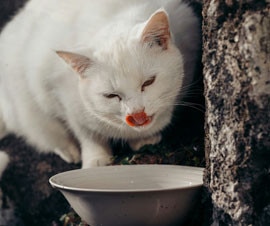
Cats may love to lap up a saucer of milk, but it may do them more harm than good, as most cats are lactose intolerant.
Cats have been part of our family since our ancestors stopped being hunter-gatherers and set up the first villages. The Ancient Egyptians loved cats so much that they painted feline images on hieroglyphs and tombs.2 They revered cats and associated them with deities, and some were even mummified alongside humans in tombs. In fact, the oldest pet cemetery, established by the Ancient Egyptians, dates to around the 1st or 2nd century CE and contains 536 cats.3 Fast forward to today, and thanks to hilarious cat memes, the popularity of this pet shows no sign of waning.

DNA evidence suggests that people first began domesticating cats around 10,000 years ago in a region of the Middle East known as the Fertile Crescent, although other estimates suggest the process may have begun as early as 12,000 years ago. This area, which encompasses parts of Iraq, Israel, Jordan, Lebanon and Syria, is where humans first started settling down and creating farms and villages.4 Modern-day cats are descended from a subspecies of the African wildcat, Felis silvestris lybica. It’s likely that thousands of years ago these felines were attracted to human settlements, enticed by the scraps of food they found there. People realised these mouse-catchers were useful companions, and a beautiful relationship was born.

A recent study in the UK shows that pet cats live for an average of 11.74 years.5 The research found that female cats have a slightly longer average lifespan at 12.51 years compared to 11.18 for males. The study also found that the breed of cat can also affect its lifespan. Burmese and Birman cats have the longest average lifespans at 14.42 years and 14.39 years, respectively. On the other hand, sphynx cats have the shortest average life expectancy at 6.68 years. Bengal cats also have relatively short lifespans at 8.5 years on average. According to the same study, non-pedigree "moggies" live on average 1.5 years longer than purebred cats. If you want your cat to live a long life, then neutering them and keeping their body weight within a healthy range can increase their longevity.

For a cat lover, few things are more comforting than when a feline friend curls up in your lap and offers a contented purr. It’s not just domestic cats that purr – larger felines such as pumas and cheetahs do too. While it might seem that cats purr purely as a sign of love, happiness or pleasure, the reality is more complicated than that.
A landmark study in 1991 revealed how cats produce the purring sound. The sound originates from the feline’s voice box, or larynx. When a cat breathes, its glottis (the area around the vocal cords), rapidly dilates and constricts, causing air to vibrate and produce the familiar purr.6
However, the question of why cats purr remains debated. Kittens start purring a few days after birth to attract their mother’s attention, and many continue to purr into adulthood to encourage their owners to feed them.
One theory is that cats purr to heal or soothe themselves. It’s been suggested that the frequency of a cat’s purr, which ranges between 20Hz and 150Hz, is physically rejuvenating, and could provide pain relief or even promote bone growth.7 Anecdotally, cats have been known to purr when they are dying or being put to sleep. Cats also sometimes purr when they are severely injured or frightened. The healing power of a cat’s purr may even translate to humans, as some studies suggest that owning a cat could cut the risk of stroke or heart disease by as much one-third.8
Cats may also purr to manipulate their owners. One study found that a "mew" sound hidden within a cat's purr can elicit nurturing feelings in owners, much like a newborn baby's cry.9 According to the authors, when purring to demand food, cats make "more urgent and less pleasant" sounds.10
While it might seem that cats purr purely as a sign of love, happiness or pleasure, the reality is more complicated than that.
Unlike the purr, which is a mainstay of feline-to-feline communication, adult cats rarely miaow at one another. For example, kittens miaow at their mothers to signal that they are hungry, but this behaviour stops once they reach adulthood. Miaowing is also uncommon in feral cat colonies11 with feral cats seldom miaowing at humans.12 It appears, therefore, that domestic cats may have finessed their miaow specifically to attract human attention and communicate with us.13
The miaow of an individual cat is quite distinct, and cats can even vary the pitch, duration and melody of their miaow depending on the meaning they want to convey and their emotional state.14

You may have noticed that when your cat is feeling extra affectionate, they will rhythmically “knead” your lap by extending and retracting their paws one at a time. Kittens knead their mother's bellies when suckling, and it’s believed this behaviour evolved to stimulate milk flow.15
It’s also possible that kneading serves as a way for kittens to bond with their mothers. Cats have scent glands on the underside of their soft paw pads, and when a cat kneads, these glands release chemical messengers called pheromones.16 While weaning her kittens, the mother cat also releases a chemical called “cat appeasing pheromone” from her sebaceous glands, which are located close to her mammary glands.17 This pheromone is thought to help with bond formation – comforting and reassuring the kittens.

Female cats reach sexual maturity by the time they are around four months old. After that, they can go into heat as often as every 2-3 weeks. Gestation lasts about 64 days, with female cats giving birth to an average of four kittens per litter. Since cats can get pregnant at almost any time, it’s not unheard of for a litter of kittens to have multiple fathers – especially in cities where there are many potential male suitors. For example, in one study in France, researchers compared a population of pet cats who lived in a rural area, with a colony of feral cats living in an urban district.18 They found that in rural areas where the cat population was sparse – and cats lived in a home environment – a few males monopolised all of the females. These males would aggressively fight off competitors, and as a result only 0-22% of litters were fathered by more than one male. However, in the urban colony, cats lived more closely together and aggression between males and females was rare. In this population, between 70 to 83% of litters were sired by more than one father.
Cats are much better at seeing in low-light conditions than humans because they have more rod photoreceptors in their retina. These receptors are highly sensitive to dim light and are particularly attuned to movement. As a result, according to the charity Cats Protection, cats can see "six to eight times better" than humans when it is dark.19
However, there’s an important trade-off. As their retinas contain so many rods, cats have fewer cone receptors, the cells responsible for seeing during daytime. As a result, their daytime visual acuity is only about one-seventh of a human's. Additionally, cats seem unable to focus on objects closer than around 30cm.

Cats don’t see colours the same way that humans do. The human eye contains three types of cone receptor – red, blue and green. Each of these receptors is activated by a corresponding frequency of light. The brain then integrates this information to help us perceive the full spectrum of visible light. Cats also have three types of cones, but the cones respond to different frequencies of light (blue, cyan, and green). This means that cats are able to perceive blue, yellow and green tones very well, but are less able to discern orange and red hues.20

Like their wild carnivorous cousins – the lion, cheetah and leopard – house cats are obligate carnivores, meaning they require certain nutrients that are only found in meat. This sets them apart from animals like dogs, which enjoy meat, but can survive without it.
One essential nutrient for cats is the amino acid taurine, which although present in algae, is almost entirely absent in plants. While humans and dogs have enzymes that can make the amino acid taurine, cats don’t, so they must get it from fresh meat.
Cats also require arachidonic acid, which is mainly found in saturated animal fats. Their bodies are also not very good at converting carotenoids from plants into vitamin A, so they need to get this micronutrient from animal sources.
However, it is possible that these nutrients could be supplied through supplements, meaning cats could theoretically be fed a plant-based or vegan diet. The first large scale study comparing the health of vegan cats with meat-fed felines was published in 2021.21 The study found that vegan cats had lower incidences of gastrointestinal disorders, and a higher proportion of vegan cats were reported to be in very good health by their owners.
In addition to tinned cat food, our outdoor roaming feline friends like to hunt their own food. Recently, researchers compiled a database of all the animals that cats have been recorded eating and where.22 The study identified more than 2000 species, including 981 birds, 463 reptiles, 431 mammals, 119 insects, and 57 amphibians. Domestic cats have even been known to hunt endangered animals, such as juvenile green sea turtles.
Don’t be tempted to give your cat chocolate – it's highly toxic to felines. Chocolate contains two compounds, theobromine and caffeine, both of which are harmful to cats. However, research shows that cats aren’t particularly interested in sweet treats anyway. This is because cats have a defect in one of the two genes responsible for forming the sweet taste receptor.23 A large deletion of DNA from the gene means that it is unable to form a functioning protein. This defect has left cats unable to taste sweet-tasting compounds like sugar. Interestingly, this genetic mutation isn't limited to domestic cats –cheetahs, tigers, and even hyenas share this trait.

Cats often like to be out at night, and so sometimes may encounter foxes. However, the risk of a fox attacking a cat is very low.24 In most cases, cats and foxes will simply ignore or avoid each other. In February 2013, vet Dr Pete Wedderburn analysed statistics from the database VetCompass, a project run by the Royal Veterinary College in London. The database collects information on vet visits - and the reasons for them - in the UK.
The results showed that in the period January 2010 until February 2013, only five out of 10,000 cats visiting a vet in the UK did so because of being injured by a fox.25 This compares to 541 cats per 10,000 who visited following a fight with another cat in the same period. Wedderburn concludes that cats are 40 times more likely to be injured by other cats, and 14 times more likely to be injured by a road traffic accident than to be hurt by a fox.

Domestic cats have a reputation for being aloof and indifferent, especially in comparison to dogs. So many owners can be forgiven for asking the question: does my cat love me? Research indicates that cats actually form very close emotional bonds with their owners.26 For instance, some cats display separation anxiety when apart from their caregiver. Cats are also more responsive to their owners’ voices than they are to a stranger’s.27 Moggies even look at their owners for reassurance when they are scared.28 In fact, one 2017 study by researchers at Oregon State University in the US found that cats preferred human interaction over food, toys or pleasant smells.29
So how can you tell whether your cat loves you? One sign to look out for is your cat rubbing its head or body against your legs. Cats have scent glands on their side, head, and around their ears. In the wild, felines use these glands to identify members of their group or family.30 So when a cat nuzzles your face, you know that it’s real love. An upright tail also shows affection, as does a slow blinking gaze.31

When a cat nuzzles your face, you know that it’s real love. An upright tail also shows affection, as does a slow blinking gaze.
Cats are obligate carnivores, which means they must eat meat to survive. Over time, they have evolved into skilled hunters to ensure a steady food supply. Their prey includes small rodents – like mice, rats and voles – as well as birds and even frogs. They often prefer to hunt at dusk and dawn, which is why you might have noticed your pet cat is especially active at these times.
However, pet cats arguably no longer need to hunt to meet their nutritional needs, as most are well-fed at home. So why do they still hunt? It’s all down to instinct. Even a well-fed cat will be driven to stalk, pounce and chase small creatures. It is hardwired into their nature and, in fact, estimates suggest that cats only consume around 30% of the prey they catch.32
Whiskers are specialised sensory organs that help cats gather information about their surroundings. As they move around, cats receive a constant stream of information from their whiskers about the objects close to them. These whiskers – also referred to as vibrissae – are found on their cheeks, near their eyes, and even on their ankles. Each of these wiry hairs sits deeply in the skin, where it connects to muscles as well as never endings. From this sensory information, the cat can tell how far each whisker is being bent back, and how quickly. A cat's cheek whiskers are approximately the same width as their body, allowing them to judge distances and to navigate the narrowest spaces.
Catnip is an oil found in the stems and leaves of the catnip plant Nepeta cataria.
When cats smell catnip they exhibit several unusual behaviours – rubbing their heads and bodies on the plant, jumping, rolling around, miaowing and salivating. Cats can detect catnip concentrations as low as one part in a billion.33 However, not all cats are affected by it. Studies estimate that about 2 in 3 cats react to it, and it appears that the response is hereditary.34 Even some big cats like leopards and tigers can greact in the same intoxicated way.
So why do cats love catnip? Catnip contains many volatile compounds, including one chemical called nepetalactone.35 This substance is made by plants to repel insects, but it has the opposite effect on cats. We don’t know why, but it’s thought that nepetalactone mimics a pheromone that cats naturally produce, one that is linked to reproduction.36
Featured image © thewonderalice | Unsplash
Fun fact image © Ibrahim Guetar | Unsplash
Quick Facts:
1 “How Long Do Pet Cats Live?” Cats Protection, www.cats.org.uk/cats-blog/how-long-do-pet-cats-live.
2. Helgren, J. Anne. “Cat.” Encyclopædia Britannica, 14 Jan. 2019, www.britannica.com/animal/cat.
3. “Cat Weight.” Blue Cross, www.bluecross.org.uk/advice/cat/food-and-weight/cat-weight.
4. “Cat Population by Country 2023.” Worldpopulationreview.com, worldpopulationreview.com/country-rankings/cat-population-by-country.
Fact file:
1. Quaranta, Angelo, et al. “Emotion Recognition in Cats.” Animals, vol. 10, no. 7, 28 June 2020, p. 1107, https://doi.org/10.3390/ani10071107.
2. Driscoll, Carlos A, et al. “The Taming of the Cat.” Scientific American, vol. 300, no. 6, June 2009, p. 68, pmc.ncbi.nlm.nih.gov/articles/PMC5790555/.
3. PhD, Todd,. “The Average Cat Lives 11.74 Years, according to New Research.” Companion Animal Psychology, Blogger, 5 June 2024, www.companionanimalpsychology.com/2024/06/the-average-cat-lives-1174-ye…. Accessed 27 Nov. 2024.
4. Driscoll, C. A., et al. “The near Eastern Origin of Cat Domestication.” Science, vol. 317, no. 5837, 27 July 2007, pp. 519–523, https://doi.org/10.1126/science.1139518.
5. Kendy Tzu-yun Teng, et al. “Life Tables of Annual Life Expectancy and Risk Factors for Mortality in Cats in the UK.” Journal of Feline Medicine and Surgery, vol. 26, no. 5, 1 May 2024, https://doi.org/10.1177/1098612x241234556.
6. Sissom, Dawn E. Frazer, et al. “How Cats Purr.” Journal of Zoology, vol. 223, no. 1, Jan. 1991, pp. 67–78, https://doi.org/10.1111/j.1469-7998.1991.tb04749.x.
7. von Muggenthaler, Elizabeth. “The Felid Purr: A Healing Mechanism?” The Journal of the Acoustical Society of America, vol. 110, no. 5, Nov. 2001, pp. 2666–2666, https://doi.org/10.1121/1.4777098.
8. Qureshi AI, Memon MZ, Vazquez G, Suri MF. 2009. Cat ownership and the Risk of Fatal Cardiovascular Diseases. Results from the Second National Health and Nutrition Examination Study Mortality Follow-up Study. J Vasc Interv Neurol. Jan;2(1):132-5.
9. McComb, Karen. “The Cry Embedded within the Purr.” Current Biology, vol. 19, no. 13, 14 July 2009, pp. R507–R508, www.sciencedirect.com/science/article/pii/S0960982209011683, https://doi.org/10.1016/j.cub.2009.05.033; Field, Alison. “Research Reveals How Cats Purrfect the Art of Exploitation.” The University of Sussex, www.sussex.ac.uk/broadcast/read/1208.
10. Yeon, S.C., Kim, Y.K., Park, S.J., Lee, S.S., Lee, S.Y., Suh, E.H., Houpt, K.A., Chang, H.H., Lee, H.C., Yang, B.G., et al. 2011. Differences between vocalization evoked by social stimuli in feral cats and house cats. Behav. Process., 87, 183–189
11. Cameron-Beaumont, C.L. 1999. Visual and Tactile Communication in the Domestic Cat (Felis silvestris catus) and Undomesticated Small Felids. Ph.D. Thesis, University of Southampton, UK
12. Atkinson, T. 2018. Practical Feline Behaviour: Understanding Cat Behaviour and Improving Welfare; CABI: Wallingford, UK.
13. Turner, D.C. 2017. A review of over three decades of research on cat-human and human-cat interactions and relationships. Behav. Process. 141, 297–304
14. Tavernier, C., Ahmed, S., Houpt, K.A., Yeon, S.C. 2020. Feline vocal communication. J. Vet. Sci. 21.
15. Bradshaw, John W.S. “Sociality in Cats: A Comparative Review.” Journal of Veterinary Behavior, vol. 11, Jan. 2016, pp. 113–124, https://doi.org/10.1016/j.jveb.2015.09.004.
16. Pageat, Patrick, and Emmanuel Gaultier. “Current Research in Canine and Feline Pheromones.” Veterinary Clinics of North America: Small Animal Practice, vol. 33, no. 2, Mar. 2003, pp. 187–211, https://doi.org/10.1016/s0195-5616(02)00128-6.
17. DePorter, Theresa L, et al. “Evaluation of the Efficacy of an Appeasing Pheromone Diffuser Product vs Placebo for Management of Feline Aggression in Multi-Cat Households: A Pilot Study.” Journal of Feline Medicine and Surgery, vol. 21, no. 4, 14 May 2018, pp. 293–305, https://doi.org/10.1177/1098612x18774437.
18. Say, Ludovic., et al. “High Variation in Multiple Paternity of Domestic Cats (Felis Catus L.) in Relation to Environmental Conditions.” Proceedings of the Royal Society of London. Series B: Biological Sciences, vol. 266, no. 1433, 22 Oct. 1999, pp. 2071–2074, www.ncbi.nlm.nih.gov/pmc/articles/PMC1690320/pdf/10902544.pdf, https://doi.org/10.1098/rspb.1999.0889. Accessed 5 Oct. 2022.
19. “Can Cats See in the Dark? And Other Cat Eyesight Facts.” Cats Protection, www.cats.org.uk/cats-blog/cat-eyesight-facts.
20. Gardner, Lori. “What Colors Can Cats See? See the World through a Cats Eyes.” Litter-Robot.com, Whisker, 4 Dec. 2023, www.litter-robot.com/blog/what-colors-can-cats-see/?srsltid=AfmBOorZaZp…. Accessed 5 Nov. 2024.
21. Dodd, Sarah A. S., et al. “A Cross-Sectional Study of Owner-Reported Health in Canadian and American Cats Fed Meat- and Plant-Based Diets.” BMC Veterinary Research, vol. 17, no. 1, 28 Jan. 2021, https://doi.org/10.1186/s12917-021-02754-8.
22. Lepczyk, Christopher A, et al. “A Global Synthesis and Assessment of Free-Ranging Domestic Cat Diet.” Nature Communications, vol. 14, no. 1, 12 Dec. 2023, https://doi.org/10.1038/s41467-023-42766-6.
23. Li, Xia, et al. “Pseudogenization of a Sweet-Receptor Gene Accounts for Cats’ Indifference toward Sugar.” PLoS Genetics, vol. 1, no. 1, 25 July 2005, p. e3, https://doi.org/10.1371/journal.pgen.0010003.
24 Cats and Foxes | Blog. 2024, www.cats.org.uk/cats-blog/are-foxes-a-danger-to-cats.
25. “Do Foxes Eat Cats? Could Your Pet Cat Be the next Victim?” Vet Help Direct, 14 Feb. 2013, vethelpdirect.com/vetblog/2013/02/14/urban-foxes-attacks-on-cat/. Accessed 5 Nov. 2024.
26. Schwartz, Stefanie. “Separation Anxiety Syndrome in Cats: 136 Cases (1991-2000).” Journal of the American Veterinary Medical Association, vol. 220, no. 7, Apr. 2002, pp. 1028–1033, https://doi.org/10.2460/javma.2002.220.1028.; Saito, Atsuko, and Kazutaka Shinozuka. “Vocal Recognition of Owners by Domestic Cats (Felis Catus).” Animal Cognition, vol. 16, no. 4, 26 Mar. 2013, pp. 685–690, https://doi.org/10.1007/s10071-013-0620-4.
27. Merola, I., et al. “Social Referencing and Cat–Human Communication.” Animal Cognition, vol. 18, no. 3, 9 Jan. 2015, pp. 639–648, https://doi.org/10.1007/s10071-014-0832-2.
28. Shreve, Kristyn R. Vitale, et al. “Social Interaction, Food, Scent or Toys? A Formal Assessment of Domestic Pet and Shelter Cat (Felis Silvestris Catus) Preferences.” Behavioural Processes, vol. 141, 2017, pp. 322–328, www.sciencedirect.com/science/article/pii/S0376635716303424, https://doi.org/10.1016/j.beproc.2017.03.016.
29. ---. “Current Research in Canine and Feline Pheromones.” Veterinary Clinics of North America: Small Animal Practice, vol. 33, no. 2, Mar. 2003, pp. 187–211, https://doi.org/10.1016/s0195-5616(02)00128-6.
30. Finka, Lauren R. “Conspecific and Human Sociality in the Domestic Cat: Consideration of Proximate Mechanisms, Human Selection and Implications for Cat Welfare.” Animals, vol. 12, no. 3, 25 Jan. 2022, p. 298, https://doi.org/10.3390/ani12030298.
31. Humphrey, Tasmin, et al. “The Role of Cat Eye Narrowing Movements in Cat–Human Communication.” Scientific Reports, vol. 10, no. 1, 5 Oct. 2020, p. 16503, www.nature.com/articles/s41598-020-73426-0, https://doi.org/10.1038/s41598-020-73426-0.
32. “Cat Hunting Behaviors.” Www.purina.com, www.purina.com/articles/cat/behavior/understanding-cats/cat-hunting-beh….
33. Lichman, Benjamin R., et al. “The Evolutionary Origins of the Cat Attractant Nepetalactone in Catnip.” Science Advances, vol. 6, no. 20, 1 May 2020, p. eaba0721, advances.sciencemag.org/content/6/20/eaba0721, https://doi.org/10.1126/sciadv.aba0721.
34. Bol, Sebastiaan, et al. “Responsiveness of Cats (Felidae) to Silver Vine (Actinidia Polygama), Tatarian Honeysuckle (Lonicera Tatarica), Valerian (Valeriana Officinalis) and Catnip (Nepeta Cataria).” BMC Veterinary Research, vol. 13, no. 13, 16 Mar. 2017, www.ncbi.nlm.nih.gov/pmc/articles/PMC5356310/#CR10, https://doi.org/10.1186/s12917-017-0987-6.
35. Adams, Christian. “How Far Away Can Cats Smell Catnip? Vet-Approved Facts & FAQ - Catster.” Catster, 13 Sept. 2024, www.catster.com/cat-behavior/how-far-away-can-cats-smell-catnip/. Accessed 5 Nov. 2024.
36. “Meet the Molecules – Catnip.” John Innes Centre, 14 Nov. 2018, www.jic.ac.uk/blog/meet-the-molecules-catnip/.
Kitten
Clowder, clutter, pounce, glaring, cluster, colony
Small creatures such as mice, rats, birds, frogs, insects
Wild or feral cats can sometimes be preyed upon by larger predators such as foxes, wolves, and large birds of prey such as owls and hawks
One study found that the average life expectancy for pet cats in the UK is 11.7 years*. However, other estimates suggest that the average cat lifespan globally is between 13-17 years. Some cats can even reach their early 20s1
According to one source, the average length of a full-grown ‘moggy’ domestic cat is between 51-71cm (1.7-2.3ft)2
It can vary by breed, but the average for a moggy is between 3.6-4.5kg (7.9-9.9 lb), roughly equivalent to the weight of a new-born baby3
Anywhere where people live
According to one estimate, there are over 480,000,000 stray cats, and around 350,000,000 pet cats globally4

Cats may love to lap up a saucer of milk, but it may do them more harm than good, as most cats are lactose intolerant.